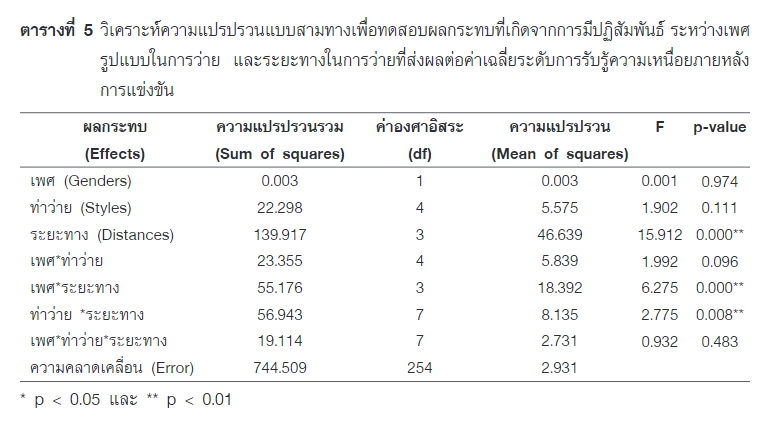POST COMPETITION PEAK BLOOD LACTATE IN YOUNG SWIMMERS : EFFECTS OF GENDER, SWIMMING STROKES AND DISTANCES
Main Article Content
Abstract
Purpose The present study attempts to describe the post competition peak lactate profile according to the gender across all the swimming strokes and swimming distances in young swimmers.
Methods Blood samples (N=284) from the ear lobe were collected by a lactate analyzer at poolside area as quickly as possible following only their finals race. Blood samples were collected at 3 mins after race completion in a total of 39 swimmers (14 young males and 25 young females). Independent t-test was use to conducted for evaluated any differences of swimming performance between boys and girls. A three-way ANOVA was conducted that examined the effect of gender and swimming styles and swimming distance on Post competition peak lactate, heart rate and RPE and Bonferroni post hoc test was used to locate the differences. Statistical significance was set at p ≤ 0.05.
Result A higher post competition blood lactate was observed in 400m individual medley (IM) (13.39 ± 3.50 mmol•L-1) in young male swimmers and 200m butterfly (8.59 ± 3.16 mmol•L-1) in young female swimmers, respectively. There was a significant interaction (p < .05) between gender, swimming strokes and distances on post competition blood lactate particularly in young male swimmers. There were also significant interactions between gender and swimming distances and between swimming styles and distance on RPE but not heart rate after competition.
Conclusion Post competition blood lactate was significantly increased in 400 m IM and 200m butterfly events for young males and young females respectively. There were gender differences in post competition blood lactates with an interaction between swimming styles and distances.
Article Details
References
Avlonitou, E. (1996). Maximal lactate values following competitive performance varying according to age, sex and swimming style. The Journal of Sports Medicine and Physical Fitness, 36(1), 24-30.
Barbosa, T. M., Fernandes, R., Keskinen, K., Colašo, P., Cardoso, C., Silva, J., and Vilas-Boas, J. (2006). Evaluation of the energy expenditure in competitive swimming strokes. International Journal of Sports Medicine, 27(11), 894-899.
Benelli, P., Ditroilo, M., Forte, R., De Vito, G., and Stocchi, V. (2007). Assessment of post-competition peak blood lactate in male and female master swimmers aged 40-79 years and its relationship with swimming performance. European Journal of Applied Physiology, 99(6), 685-693.
Bonifazi, M., Martelli, G., Marugo, L., Sardella, F., and Carli, G. (1993). Blood lactate accumulation in top level swimmers following competition. Journal of Sports Medicine and Physical Fitness, 33,13-18.
Bonifazi, M., Sardella, F., and Lupo, C. (2000). Preparatory versus main competitions: differences in performances, lactate responses and pre-competition plasma cortisol concentrations in elite male swimmers. European Journal of Applied Physiology, 82(5-6), 368-373.
Chatard, J., Paulin, M., and Lacour, J. (1988). measurements and swimming performance: illustrated by data from a 400 m Olympic record holder. Swimming science V. Human Kinetics, Champaign.
Elliott AC, Woodward WA (2007). Statistical analysis quick reference guidebook with SPSS examples. 1st ed. London: Sage Publications.
Hopkins, W., Marshall, S., Batterham, A., and Hanin, J. (2009). Progressive statistics for studies in sports medicine and exercise science. Medicine and Science in Sports and Exercise, 41(1), 3.
Jacobs, I. (1986). Blood lactate: implications for training and sports performance. Sports Medicine, 3(1), 10-25.
Laffite, L. P., Vilas-Boas, J. P., Demarle, A., Silva, J., Fernandes, R., and Louise Billat, V. (2004). Changes in physiological and stroke parameters during a maximal 400-m free swimming test in elite swimmers. Canadian Journal of Applied Physiology, 29(S1), S17-S31.
Morais, J. E., Garrido, N. D., Marques, M. C., Silva, A. J., Marinho, D. A., and Barbosa, T. M. (2013). The influence of anthropometric, kinematic and energetic variables and gender on swimming performance in youth athletes. Journal of Human Kinetics, 39(1), 203-211.

